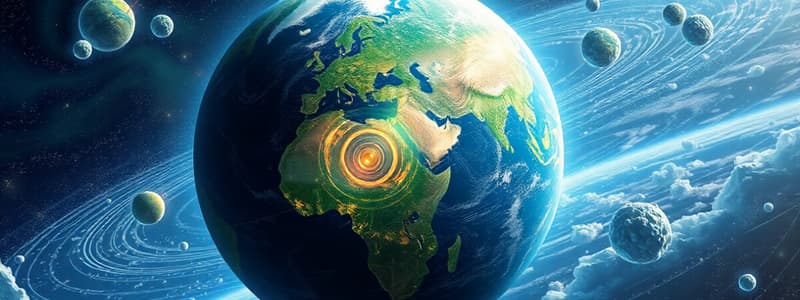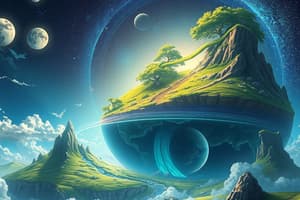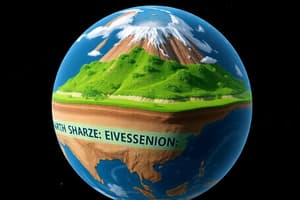Podcast
Questions and Answers
Which of the following best describes the composition of metamorphic rocks?
Which of the following best describes the composition of metamorphic rocks?
- They are created from the cooling and solidification of magma.
- They form exclusively from volcanic activity.
- They originate from the alteration of existing rocks due to heat and pressure. (correct)
- They are primarily composed of sediments and fossils.
What is a key characteristic that distinguishes foliate metamorphic rocks from non-foliated ones?
What is a key characteristic that distinguishes foliate metamorphic rocks from non-foliated ones?
- Foliated rocks are composed mainly of marble.
- Foliated rocks are subjected to high heat and exhibit layering. (correct)
- Non-foliated rocks are formed only from organic materials.
- Non-foliated rocks exhibit a layered or banded appearance.
Which sedimentary rock class is formed primarily from dead plants and animals?
Which sedimentary rock class is formed primarily from dead plants and animals?
- Clastic
- Organic (correct)
- Metamorphic
- Chemical
What process is NOT a factor affecting the formation of sedimentary rocks?
What process is NOT a factor affecting the formation of sedimentary rocks?
Which of the following rocks is an example of a non-foliated metamorphic rock?
Which of the following rocks is an example of a non-foliated metamorphic rock?
Which characteristic is NOT a unique trait of Earth that allows it to sustain life?
Which characteristic is NOT a unique trait of Earth that allows it to sustain life?
What role does the Moon play in relation to Earth?
What role does the Moon play in relation to Earth?
Which of the following is NOT part of the biosphere's function?
Which of the following is NOT part of the biosphere's function?
What is the primary focus of mining?
What is the primary focus of mining?
Which cycle involves the process of evaporation, condensation, and precipitation?
Which cycle involves the process of evaporation, condensation, and precipitation?
Which of the following accurately describes mineral reserves?
Which of the following accurately describes mineral reserves?
What type of rock is formed from the cooling of hot molten rock?
What type of rock is formed from the cooling of hot molten rock?
How are metamorphic rocks primarily formed?
How are metamorphic rocks primarily formed?
Which mining method is characterized by surface extraction that maintains exposure throughout the extraction process?
Which mining method is characterized by surface extraction that maintains exposure throughout the extraction process?
What is a common characteristic of underground mining methods compared to open pit mining?
What is a common characteristic of underground mining methods compared to open pit mining?
Which is a characteristic of mafic rocks?
Which is a characteristic of mafic rocks?
Which of the following cycles involves the reuse of carbon atoms?
Which of the following cycles involves the reuse of carbon atoms?
Which type of underground mining method involves creating tunnels in a chess board pattern?
Which type of underground mining method involves creating tunnels in a chess board pattern?
What is a key benefit of open pit mining?
What is a key benefit of open pit mining?
Which mining method is specifically designed for extracting resources in an aquatic environment?
Which mining method is specifically designed for extracting resources in an aquatic environment?
What distinguishes industrial minerals from ores?
What distinguishes industrial minerals from ores?
What percentage of Earth's water is found in oceans?
What percentage of Earth's water is found in oceans?
Which layer of soil is rich in organic matter and is referred to as Humus?
Which layer of soil is rich in organic matter and is referred to as Humus?
What is the primary form of freshwater on Earth?
What is the primary form of freshwater on Earth?
Which of the following is NOT a component of soil?
Which of the following is NOT a component of soil?
What percentage of total land is considered arable?
What percentage of total land is considered arable?
Which water body type is characterized as stationary?
Which water body type is characterized as stationary?
What is the primary purpose of crop rotation?
What is the primary purpose of crop rotation?
Which layer of soil contains few organic matters and has a zone of accumulation of soluble minerals?
Which layer of soil contains few organic matters and has a zone of accumulation of soluble minerals?
Flashcards are hidden until you start studying
Study Notes
Earth's Subsystems
- Earth is the only planet known to support life, featuring self-sustaining characteristics.
- Unique traits include a protective atmosphere, water sources, a strong magnetic field, specific axial tilt, and a suitable distance from the Sun, along with the presence of the Moon.
- The Moon has its own gravitational pull, influencing ocean tides and acting as a satellite for Earth.
Earth's Subsystems Components
- Biosphere: Crucial subsystem maintaining balance among the four subsystems.
- Hydrosphere: Comprises all water bodies, serving as a habitat for organisms.
- Atmosphere: Contains gases that shape climate and weather patterns.
- Geosphere: Encompasses rocks and minerals, providing natural pathways for water and materials.
Cycles
- Water Cycle: Involves the continuous movement of water through evaporation, condensation, and precipitation.
- Rock Cycle: Describes the formation and transformation of rocks influenced by heat and pressure.
- Includes Igneous, Sedimentary, and Metamorphic rock types.
- Carbon Cycle: Recycles carbon atoms between the atmosphere, organisms, and sedimentary rocks, with fossilized organisms contributing to carbon pools.
- Oxygen Cycle: Entails the circulation of oxygen atoms essential for life forms.
Rock Classifications
- Rocks: Solid aggregates of minerals. Historically used for weaponry, construction, and jewelry.
Types of Rocks
-
Igneous Rocks: Formed from cooled molten rock.
- Intrusive (Plutonic): Cooled underground, featuring large crystals.
- Extrusive (Volcanic): Cooled on the surface, with smaller crystals.
- Compositions include Felsic, Mafic, and Intermediate based on mineral content.
-
Metamorphic Rocks: Formed from existing rocks altered by heat, pressure, and mineral fluids.
- May be Foliated (layered) or Non-Foliated (not layered).
- Example minerals include Gneiss, Marble, and Quartzite.
-
Sedimentary Rocks: Generated from the accumulation and compaction of sediments.
- Classified into Organic, Clastic, and Chemical based on formation processes.
- Characterized by layers ("strata"), visible particles of varying sizes, and often contain fossils.
Mining
- Mining: Involves extracting non-renewable resources using various methods.
Key Terms
- Natural Resources: Include both renewable and non-renewable materials.
- Mineral Resources: Total minerals found on Earth.
- Mineral Reserves: Amount of minerals available for extraction.
Mining Methods
- Open Pit Mining: Surface extraction method that exposes mineral deposits.
- Underground Mining: Extracts minerals from below the surface using horizontal or vertical access points.
- Methods include Room & Pillar, Narrow Vein, Long Wall, and Underwater Mining.
Water and Soil
- Water: Comprises 97% saltwater and 3% freshwater, with most freshwater stored in glaciers.
- Water is crucial to ecosystems and supports the majority of life on Earth.
- Reservoir: Storage location for water in various forms.
- Residence Time: Duration water remains in a reservoir.
Water Systems
- Lentic Systems: Stationary water bodies like lakes and ponds.
- Lotic Systems: Flowing water bodies including rivers and streams.
Soil
- Comprised of unconsolidated rocks, water, air, and organic matter, supporting plant growth.
- Humus: Organic matter that enhances soil structure and fertility.
Soil Layers
- Horizon 0 (Humus): Rich in organic matter.
- Horizon A (Topsoil): Contains minerals and organic content.
- Horizon B (Subsoil): Less organic matter; accumulates soluble minerals.
- Horizon C (Parent Material): Contains weathered rocks with minimal organic matter.
- Horizon R (Bedrock): Solid rock layer beneath the soil.
Soil and Water Conservation
- Advocates for responsible resource use and waste management.
- Crop rotation promotes nutrient circulation in soil.
- Implementation of organic matter improves soil health.
Studying That Suits You
Use AI to generate personalized quizzes and flashcards to suit your learning preferences.




